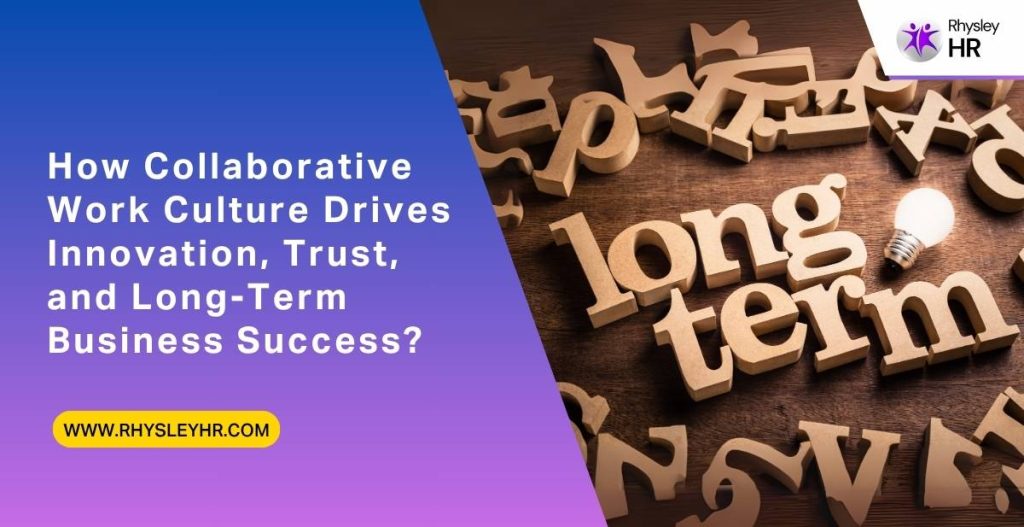Explore all premium features with a 1-Year Free Trial. Schedule your demo NOW!

How Collaborative Work Culture Drives Innovation, Trust, and Long-Term Business Success?
In today’s digitally driven world, organizations that prioritize collaborative work culture are consistently outperforming their competitors. The major shift from hierarchical structures to team-based work environment has completely changed how companies nurture innovation, build trust among employees, and lay the foundation for long-term business success.
Before we dive into its intricacies, it is important to first understand what teamwork culture implies. A strong teamwork culture is a set of shared beliefs and values that promote collaboration and trust within an organization. It’s an environment where employees come together to work towards a common purpose. Now, let’s explore how employee collaboration and team-based work environments are integral for long-term business growth.
Benefits of Workplace Collaboration
Let’s have a look at some of the benefits of working as a team:
Diversity Fuels Innovation
A collaborative work culture brings together individuals from different educational backgrounds, skill sets, and experiences. This diversity naturally results in fresh, innovative ideas. When employees feel encouraged to share and build upon each other’s thoughts, path-breaking solutions take place. Ultimately, this is the essence of how collaboration boosts innovation.
Increased Problem-Solving Capacity
Complex challenges in the workplace often require more than one perspective for effective solutions. Teamwork in the workplace encourages brainstorming, knowledge sharing, and constructive debates which eventually lead to robust and effective solutions.
Enhanced Learning and Skill Development
Employees working in collaborative teams often get to learn from each other, pick up new skills, and strengthen their own capabilities. This kind of exposure builds a more agile and versatile workforce.
Enhanced Employee Engagement
One of the most overlooked team benefits is the sense of belonging and support that employees feel when working together as a team. When employees know that their contributions matter and are appreciated, it naturally boosts morale.
Faster and More Efficient Project Execution
In a collaborative work culture, responsibilities can be divided based on strengths and quick decisions can be made. This ultimately results in higher efficiency and timely completion of tasks, directly boosting productivity.
Building a Collaborative Company Culture
While the benefits of workplace collaboration are quite evident, they don’t just materialize on their own. A cohesive unit requires intentional cultural building and the right infrastructure to sustain it. Here’s how to start building a collaborative company culture:
Lead by Example
HR professionals, managers, and business leaders should actively demonstrate collaborative behavior. Encouraging open dialogue and acknowledging team achievements helps set a collaborative tone across the organization.
Investing in the Right Technology
This is where a sophisticated HRMS software can be a game-changing tool. A platform that enables honest communication, constructive feedback, project tracking, and performance tracking, makes it easier for teams and the HR professionals to stay aligned and connected.
Promote Transparency and Accountability
A culture of collaboration thrives when there is clear transparency about roles, responsibilities, and goals. HRMS systems can help set clear roles, track contributions, and ensure everyone is on the same page.
Foster Psychological Safety
Employees must feel safe and secure to express their new ideas, voice any concerns, and make mistakes without the fear of judgment. HR and leadership teams should prioritize creating inclusive spaces where trust is nurtured.
The Role of Teamwork in Business Success
When different teams work in harmony, a company becomes more resilient and customer-focused. Let’s have a look at some of the key long-term advantages:
Stronger Employee Retention
Employees are more likely to stay at organizations where they feel valued, appreciated, and empowered. Employee collaboration strengthens relationships, reduces burnout, and contributes to a healthier workplace culture.
Sustainable Growth and Innovation
Companies with a collaborative work culture tend to innovate consistently and scale faster. After all, innovation is no longer a department’s job. Rather, it is a collective responsibility.
Greater Agility
When teams collaborate well, they can execute solutions faster and share critical information; giving the business a competitive edge.
Reputation as a Preferred Employer
Organizations known for strong collaboration attract top talent in the industry. In today’s highly competitive market, this reputation is invaluable for long-term success.
How HRMS Software Boosts a Collaborative Culture
A robust HRMS software platform is a powerful tool that fosters a more connected, motivated, and collaborative workplace. Here’s how it supports a team-based work environment:
Centralized Communication Tools
From chat modules to shared calendars and important announcements, an HRMS system keeps everyone informed and connected throughout the organization.
Performance and Goal Alignment
With proper, documented tracking, teams can align their efforts toward shared goals, ultimately enhancing mutual accountability.
Employee Feedback and Recognition
Peer-to-peer recognition and constructive feedback features promote a culture of open communication. With employee engagement software, HR can gather employees’ opinions in real-time, recognize efforts, and make employees feel valued.
Collaboration is the Future of Work
In today’s digitally driven world, building a collaborative company culture is no longer optional—it’s a necessity. Companies that recognize the benefits of teamwork in the workplace and intentionally build systems to support it, are positioned for sustained success.
Modern HRMS software isn’t just about payroll or attendance; it’s about enhancing employee engagement, and creating a workplace where employees feel motivated and connected. After all, a place where employees collaborate, businesses elevate.